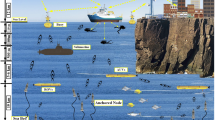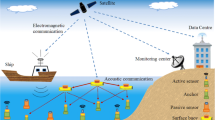Abstract
Marine life and environmental monitoring of deep sea have become a major field of interest for quite a long time because of the immeasurable region of the area of the ocean that comes with its own dynamics and vulnerabilities. Creating the Underwater-Internet of Things (U-IoT) model within Underwater Wireless Sensor Network (UWSN) provides the scope of ensuring proper marine life monitoring which supports the aspects of 4th Industrial Revolution. The U-IoT network model is designed for an automated, efficient, smart process of data transfer for both underwater and overwater communications through acoustic waves and Radio Frequency (RF) data transfer techniques, respectively. The proposed U-IoT network model is created with an optimum number of autonomous underwater vehicles (AUVs) and surface sinks in order to address Bangladesh’s overfishing problem (e.g., hilsa overfishing problem) which guarantees efficient management of the banning period by the authority. The network model is evaluated by comparing different deployment methods of AUVs and surface sinks taking the South Patch region of Bay of Bengal as the target area. The result shows that the proposed model transfers adequate data of marine life motion from the seafloor can enhance efficient administration of the overfishing problem.
Access this chapter
Tax calculation will be finalised at checkout
Purchases are for personal use only
Similar content being viewed by others
References
Leape, J., William, E.P.: Harnessing the Fourth Industrial Revolution for Oceans. World Economic Forum (2017)
Byun, J.I., Choi, S.W., Song, M.H., Chang, B.U., Kim, Y.J., Yun, J.Y.: A large buoy-based radioactivity monitoring system for gamma-ray emitters in surface seawater. Appl. Radiat. Isot. 162, 109172 (2020)
Muller-Karger, F.E., Miloslavich, P., Bax, N.J., Simmons, S., Costello, M.J., Sousa Pinto, I., Canonico, G., Turner, W., Gill, M., Montes, E., et al.: Advancing marine biological observations and data requirements of the complementary essential ocean variables (EOVs) and essential biodiversity variables (EBVs) frameworks. Frontiers Mar. Sci. 5, 211 (2018)
Meyer, V., Audoly, C.: A parametric study of the environment and the array configuration for underwater noise measurement from ships in shallow water. In: Proceedings of the 26th International Congress on Sound and Vibrations (2019)
Williams, M., Kookana, R.S., Mehta, A., Yadav, S., Tailor, B., Maheshwari, B.: Emerging contaminants in a river receiving untreated wastewater from an Indian Urban Centre. Sci. Total Environ. 647, 1256–1265 (2019)
Hall-Spencer, J.M., Harvey, B.P.: Ocean acidification impacts on coastal ecosystem services due to habitat degradation. Emerg. Topics Life Sci. 3(2), 197–206 (2019)
Bernard, C., Bouvet, P.J., Pottier, A., Forjonel, P.: Multiple access acoustic communication in underwater mobile networks. In: 2021 Fifth Underwater Communications and Networking Conference (UComms) (2021)
Chen, J., Dai, Z., Chen, Z.: Development of radio-frequency sensor wake-up with unmanned aerial vehicles as an aerial gateway. Sensors 19(5), 1047 (2019)
Huang, J., Wang, H., He, C., Zhang, Q., Jing, L.: Underwater acoustic communication and the general performance evaluation criteria. Frontiers Inform. Technol. Electron. Eng. 19(8), 951–971 (2018)
Das, B., Ali, K., Memon, S., Shakoor, A., et al.: Monitoring of water quality of aquarium by using IoT technology. J. Appl. Eng. Technol. (JAET) 4(2), 22–34 (2020)
Kim, S., Choi, J.W.: Optimal deployment of sensor nodes based on performance surface of underwater acoustic communication. Sensors 17(10), 2389 (2017)
Duan, J.L., Lin, B., Cai, L.X., Liu, Y.X., Wu, Y.: Node deployment of marine monitoring networks: a multiobjective optimization scheme. Sensors 20(16), 4480 (2020)
Reddy, T., Swarna Priya, R.M., Parimala, M., Chowdhary, C.L., Hakak, S., Khan, W.Z., et al.: A deep neural networks based model for uninterrupted marine environment monitoring. Comput. Commun. 157, 64–75 (2020)
Ghoreyshi, S.M., Shahrabi, A., Boutaleb, T.: An efficient AUV-aided data collection in underwater sensor networks. In: 2018 IEEE 32nd International Conference on Advanced Information Networking and Applications (AINA), pp. 281–288. IEEE (2018)
Yoon, S., Azad, A.K., Oh, H., Kim, S.: AURP: An AUV-aided underwater routing protocol for underwater acoustic sensor networks. Sensors 12(2), 1827–1845 (2012)
Zenia, N.Z., Aseeri, M., Ahmed, M.R., Chowdhury, Z.I., Kaiser, M.S.: Energy-efficiency and reliability in MAC and routing protocols for underwater wireless sensor network: a survey. J. Netw. Comput. Appl. 71, 72–85 (2016)
Arul, R., Alroobaea, R., Mechti, S., Rubaiee, S., Andejany, M., Tariq, U., Iftikhar, S.: Intelligent data analytics in energy optimization for the internet of underwater things. Soft Comput. 25(18), 12507–12519 (2021)
Miah, M.S.: Climatic and anthropogenic factors changing spawning pattern and production zone of Hilsa fishery in the bay of Bengal. Weather Clim. Extremes 7, 109–115 (2015)
Kim, S., Choi, J.W.: Optimal deployment of vector sensor nodes in underwater acoustic sensor networks. Sensors 19(13), 2885 (2019)
González-García, J., Gómez-Espinosa, A., Cuan-Urquizo, E., García-Valdovinos, L.G., Salgado-Jiménez, T., Cabello, J.A.E.: Autonomous underwater vehicles: localization, navigation, and communication for collaborative missions. Appl. Sci. 10(4), 1256 (2020)
Mekki, K., Bajic, E., Chaxel, F., Meyer, F.: A comparative study of LPWAN technologies for large-scale IoT deployment. ICT Exp. 5(1), 1–7 (2019)
Author information
Authors and Affiliations
Corresponding author
Editor information
Editors and Affiliations
Rights and permissions
Copyright information
© 2023 The Author(s), under exclusive license to Springer Nature Singapore Pte Ltd.
About this paper
Cite this paper
Sazzad, A., Nawer, N., Mahbub Rimi, M., Habibul Kabir, K., Foysal Haque, K. (2023). Designing of an Underwater-Internet of Things (U-IoT) for Marine Life Monitoring. In: Hossain, M.S., Majumder, S.P., Siddique, N., Hossain, M.S. (eds) The Fourth Industrial Revolution and Beyond. Lecture Notes in Electrical Engineering, vol 980. Springer, Singapore. https://doi.org/10.1007/978-981-19-8032-9_21
Download citation
DOI: https://doi.org/10.1007/978-981-19-8032-9_21
Published:
Publisher Name: Springer, Singapore
Print ISBN: 978-981-19-8031-2
Online ISBN: 978-981-19-8032-9
eBook Packages: Computer ScienceComputer Science (R0)




